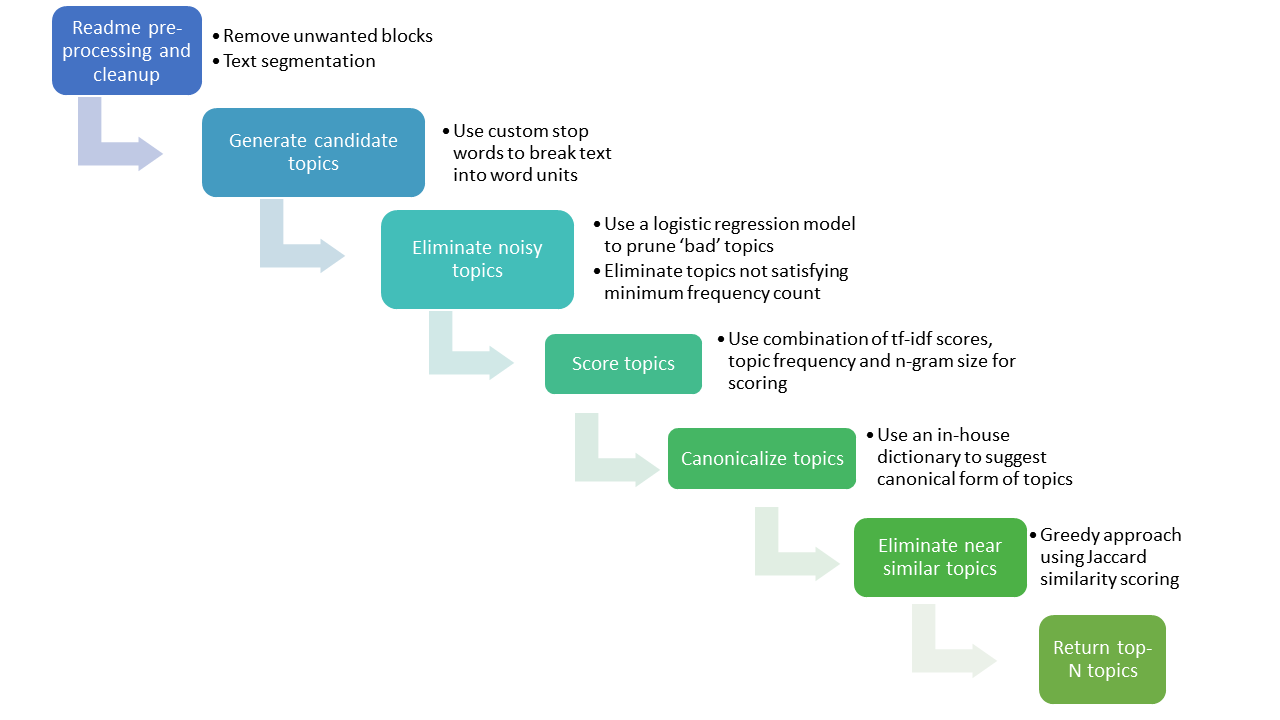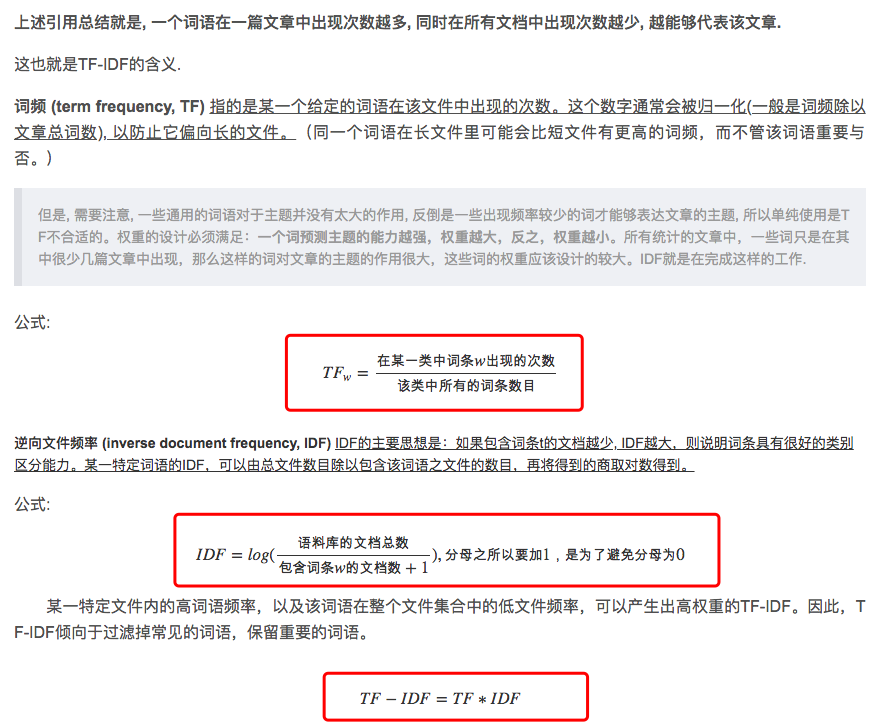Topic Suggestions for Millions of Repositories
总体流程图

分为七个步骤:
Readme 预处理与清除
(Readme preprocessing and cleanup)
- 移除不要的文本块(Remove unwanted blocks)
- 去除没用文本:一些块是没用的,比如code, table 和image链接等
- 文本划分(Text segmentation)
- 提取有用的文本:一个启发式的README tagger,借助格式分析:分析缩进(indentation),空格(spacing),和反撇号( `, backtick)等决定是否是有用信息【说明:这里语法分析是没必要的,我们只关心有用的文本,其他的都是为噪音(noise)】
- 提取到有用文本后,删除拓展部分:HTML标签,路径和其他处理出来的部分等
- 最后将剩下的文本进行粗粒度分割【用标点符号(punctuation marks)和README中的一些符号,比如临近哈希符号(contiguous hash symbols)】
生成候选主题
(Generate candidate topics)
- 用自定义的停用词去将词单元划分出来(Use custom stop words to break text into word units)
- 停用词去除
- n-gram分段小于等于4(测试发现小于4的比较好,太长的主题过于具体了,不合适)
移除噪音主题
(Eliminate noisy topics)
- 用逻辑回归模型删减“bad”主题(Use a logistic regression model to prune “bad” topics)
- 监督逻辑回归模型(supervised logistic regression model)主要针对除了频数比较小的外,一些不好的,比如”great”, “cool”等,这里的模型是一个分类模型,分为两类(good[positive] and bad(negative)), 我们称之为关键词过滤模型
- 手动收集大约300个数据集作为训练集
- 单个动词一般都是Bad类
请教师兄 - 其他的(
Other features we used were occurrence of user names, n-gram size of a phrase, length of a phrase, and numeric content within a phrase.) - 以后打算加入回馈机制(来自用户的)去更新这个关键词过滤模型:接受度高的词作为positive的,接受度低的作为停用词或者negative的
- 监督逻辑回归模型(supervised logistic regression model)主要针对除了频数比较小的外,一些不好的,比如”great”, “cool”等,这里的模型是一个分类模型,分为两类(good[positive] and bad(negative)), 我们称之为关键词过滤模型
- 移除不满足最小频数的主题(Eliminate topics not satisfying minimum frequency count)
给主题评分
(Score Topics)
- 用混合tf-idf分数,以主题频率和n元词作为打分标准(Use combination of tf-idf scores, topic frequency and n-gram size for scoring)
- 评估多种指标后,选择了点互信息指标(PMI): Pointwise Mutual Information
- 考虑另一种指标tf-idf:参考论文Using TF-IDF to Determine Word Relevance in Document Queries.pdf或者Python的实现
The second approach we tried uses the average tf-idf scores of individual words in a phrase weighted by the phrase frequency (if it’s more than one word long) and n-gram size.- 两种方法比较:
- PMI: 强调独特性,越特殊的短语评分越高,但有些可能只是拼写错误(Typo)或者是没有被删除的代码片段
- tf-idf: 不强调独特性,最终选择是tf-idf,原因是这个指标较好的平衡了独特性和主题与仓库(repository)的相关程度
- 在tf-idf的基础上还添加了一下其他的比如boosting scores等方法
- 下面是TF-IDF的说明*

规范化主题
(Canonicalize topics)
使用内部词典规范主题形式(Use an in-house dictionary to suggest canonical form of topics)
解决文字层面的差别和变化等,比如下面四个主题
neural-network
neural-networks
neuralnetwork
neuralnetworks
移除相似的主题
(Eliminate near similar topics)
用基于Jaccard相似性评分的贪心算法(Greedy approach using Jaccard similarity scoring)
motivation:在得到Top-N的主题后,有些主题其实很相似,虽然都有用,但是他们只是在不同粒度描述了同一个主题而已,因此我们需要删除一些重复的,比如下面的例子
machine learning
deep learning
general-purpose machine learning
machine learning library
machine learning algorithms
distributed machine learning
machine learning framework
deep learning library
support vector machine
linear regressionmethod: 两个短语的相似性计算使用的是基于词的Jaccard相似性(两个短语的差集与并集的比值,因为它对较短的短语很有效,而且分数是[0-1]的,很方便设置阈值(thresholds)),用贪心算法,如果两个主题相似,去除分数较低的那一个,上面的例子去除相似主题后的结果是:
machine learning
deep learning
support vector machine
linear regression